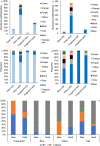Used disposable face masks are significant sources of microplastics to environment
- PMID: 34087638
- PMCID: PMC8802354
- DOI: 10.1016/j.envpol.2021.117485
Used disposable face masks are significant sources of microplastics to environment
Abstract
The consumption of disposable face masks increases greatly because of the outbreak of the COVID-19 pandemic. Inappropriate disposal of wasted face masks has already caused the pollution of the environment. As made from plastic nonwoven fabrics, disposable face masks could be a potential source of microplastics for the environment. In this study, we evaluated the ability of new and used disposable face masks of different types to release microplastics into the water. The microplastic release capacity of the used masks increased significantly from 183.00 ± 78.42 particles/piece for the new masks to 1246.62 ± 403.50 particles/piece. Most microplastics released from the face masks were medium size transparent polypropylene fibers originated from the nonwoven fabrics. The abrasion and aging during the using of face masks enhanced the releasing of microplastics since the increasing of medium size and blue microplastics. The face masks could also accumulate airborne microplastics during use. Our results indicated that used disposable masks without effective disposal could be a critical source of microplastics in the environment. The efficient allocation of mask resources and the proper disposal of wasted masks are not only beneficial to pandemic control but also to environmental safety.
Keywords: COVID-19; Face mask; Microplastics; Nonwoven fabrics; Release.
Copyright © 2021 Elsevier Ltd. All rights reserved.
Conflict of interest statement
The authors declare that they have no known competing financial interests or personal relationships that could have appeared to influence the work reported in this paper.
Figures





Similar articles
- Release kinetics of microplastics from disposable face masks into the aqueous environment.Sci Total Environ. 2022 Apr 10;816:151650. doi: 10.1016/j.scitotenv.2021.151650. Epub 2021 Nov 13.Sci Total Environ. 2022.PMID: 34780824Free PMC article.
- Neglected microplastics pollution in global COVID-19: Disposable surgical masks.Sci Total Environ. 2021 Oct 10;790:148130. doi: 10.1016/j.scitotenv.2021.148130. Epub 2021 May 29.Sci Total Environ. 2021.PMID: 34091337Free PMC article.
- Uncovering the release of micro/nanoplastics from disposable face masks at times of COVID-19.J Hazard Mater. 2021 Oct 5;419:126507. doi: 10.1016/j.jhazmat.2021.126507. Epub 2021 Jun 26.J Hazard Mater. 2021.PMID: 34323718Free PMC article.
- Environmental risks of polymer materials from disposable face masks linked to the COVID-19 pandemic.Sci Total Environ. 2022 Apr 1;815:152980. doi: 10.1016/j.scitotenv.2022.152980. Epub 2022 Jan 8.Sci Total Environ. 2022.PMID: 35007580Free PMC article.Review.
- Face masks: a COVID-19 protector or environmental contaminant?Environ Sci Pollut Res Int. 2023 Sep;30(41):93363-93387. doi: 10.1007/s11356-023-29063-x. Epub 2023 Aug 7.Environ Sci Pollut Res Int. 2023.PMID: 37548785Review.
Cited by
- The impact of plastic during the COVID-19 pandemic: The point of view of the environmental science literature.Mater Today Proc. 2023;80:1448-1455. doi: 10.1016/j.matpr.2023.01.268. Epub 2023 Feb 1.Mater Today Proc. 2023.PMID: 36743883Free PMC article.
- Nanotechnology-based approaches in the fight against SARS-CoV-2.AIMS Microbiol. 2021 Oct 12;7(4):368-398. doi: 10.3934/microbiol.2021023. eCollection 2021.AIMS Microbiol. 2021.PMID: 35071938Free PMC article.Review.
- Impact of coronavirus pandemic litters on microfiber pollution-effect of personal protective equipment and disposable face masks.Int J Environ Sci Technol (Tehran). 2022 Aug 20:1-20. doi: 10.1007/s13762-022-04462-8. Online ahead of print.Int J Environ Sci Technol (Tehran). 2022.PMID: 36035637Free PMC article.Review.
- Unraveling the potential human health risks from used disposable face mask-derived micro/nanoplastics during the COVID-19 pandemic scenario: A critical review.Environ Int. 2022 Dec;170:107644. doi: 10.1016/j.envint.2022.107644. Epub 2022 Nov 17.Environ Int. 2022.PMID: 36413926Free PMC article.Review.
- The Possibility of Reuse of Nanofiber Mats by Machine Washing at Different Temperatures.Materials (Basel). 2021 Aug 24;14(17):4788. doi: 10.3390/ma14174788.Materials (Basel). 2021.PMID: 34500878Free PMC article.
References
- Cole M., Lindeque P., Halsband C., Galloway T.S. Microplastics as contaminants in the marine environment: a review. Mar. Pollut. Bull. 2011;62:2588–2597. - PubMed
- Dris R., Gasperi J., Mirande C., Mandin C., Guerrouache M., Langlois V., Tassin B. A first overview of textile fibers, including microplastics, in indoor and outdoor environments. Environ. Pollut. 2017;221:453–458. - PubMed
MeSH terms
Substances
LinkOut - more resources
Full Text Sources
Medical
Research Materials

